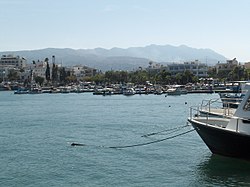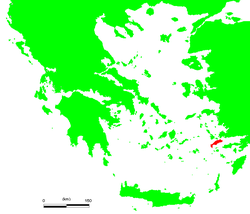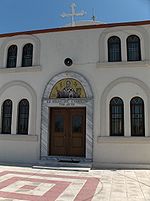This is an old revision of this page, as edited by Demonax~enwiki (talk | contribs) at 14:13, 9 November 2006. The present address (URL) is a permanent link to this revision, which may differ significantly from the current revision.
Revision as of 14:13, 9 November 2006 by Demonax~enwiki (talk | contribs)(diff) ← Previous revision | Latest revision (diff) | Newer revision → (diff) For other uses, see Kos (disambiguation).
Kos or Cos (36°51′N 27°14′E / 36.850°N 27.233°E / 36.850; 27.233, Greek: Κως) is a Greek island in the Dodecanese group of islands, in the Aegean Sea, which it separates from the Gulf of Cos. It measures 40 km by 8 km, and is only 4 km from the coast of Bodrum in Turkey. The island has both fertile plains and infertile highlands. Population: 30,500.
History
The island was originally colonised by the Carians. The Dorians invaded in the 11th century BC and joined the Athenian Federation, expelling the Persians twice. In 366 BC the town of Kos was built, then soon after the island became a part of the Roman Empire, then the Byzantine Empire.

The island was later conquered by the Venetians, who then sold it to The Knights of Saint John of Rhodes. Two hundred years later the Knights faced the threat of a Turkish invasion, and so abandoned the island. The Ottoman Empire ruled Kos for 400 years until it was transferred to Italy in 1912. In World War II, the island was taken over by Germany, until 1945, when it became a protectorate of Britain, who ceded it to Greece in 1947.
Geography

The island is part of a chain of mountains from which it became separated after earthquakes and subsidence that occurred in ancient times. These mountains include Kalymnos and Kappari which are separated by an underwater chasm 40 fathoms deep, as well as the volcano of Nisyros and the surrounding islands.
There is a wide variety of rocks in Kos which is related to its geographical formation. Prominent among these are the Quaternary layers in which the fossil remains of mammals such as horses, hippopotami and elephants have been found. The fossil molar of an elephant of gigantic proportions was presented to the Paleontology Museum of the University of Athens.
The shores of Kos Island are washed by the waters of the Karpathian Sea. Its coastline is 112 km long and is caressed by long immaculate beaches, leading to its main industry being tourism. Farming is the principal occupation of many of the island's inhabitants, with their main crops being grapes, almonds, figs, olives, and tomatoes, along with wheat and corn. Cos lettuce may be grown here, but the name is unrelated.
Culture
The main port and population centre on the island, also called Kos, is also the tourist and cultural centre, with whitewashed buildings including many hotels, restaurants and a small number of nightclubs forming the famous Kos town "barstreet". The town has a 14th century fortress at the entrance to its harbour, erected in 1315 by The Knights of Saint John of Rhodes.

The ancient physician Hippocrates is thought to have been born on Kos, and in the center of the town is the Plane Tree of Hippocrates, a dream temple where the physician is traditionally supposed to have taught. The limbs of the now elderly tree are supported by scaffolding. The small city is also home to the International Hippocratic Institute and the Hippocratic Museum dedicated to him. Near the Institute are the ruins of Asklepieion, where Herodicus taught Hippocrates medicine.
The main villages of Kos island are Kardamena, Kefalos, Tigaki, Antimachia, Mastihari, Marmari and Pyli. Smaller ones are Zia, Zipari, Platani, Lagoudi and Asfendiou. Kardamena is now a popular resort for young British holidaymakers and has a large number of bars and nightclubs.
Religion

The main religion practiced is Greek Orthodoxy and as such, Kos has one of the four cathedrals in the entire Dodecanese. There is also a Roman Catholic Church on the island as well as a Mosque catering to the Muslim community of Kos. The Synagogue is no longer used for religious ceremonies as the Jewish community of Kos was practically wiped out by the Nazis in World War Two. It has however been restored and is maintained with all religious symbols intact and is now used by the Municipality of Kos for various events, mainly cultural.
References
- Originally based on an article by Kos Island.info, licensed under the GNU Free Documentation License, used with permission.
External links
- Kos island directory: Kos Island directory
- Kos: Municipal Tourism Organisation Official site (Not updated)
- The Engravings of Kos by Alekos J. Markoglou